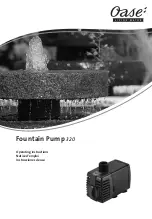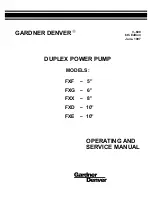
12. TROUBLESHOOTING
IMPORTANT:
Before commencing any maintenance on your Koi Air pump,
ensure it is isolated from the mains electricity supply.
Low Air Output / Noisy Operation
I
Is the pump on a sounding board, such as a wooden shed floor, if so place the pump on
a patio slab that will reduce the effect or relocate.
I
Tip, using silicone air line will help reduce noise. Ensure that no more than 15% of the
air pumps output is being restricted (see below).
I
Are the air line check valves blocked or the air lines kinked.
I
If the pump is too powerful for your immediate requirements opening one of the air
divider valves without any air line will bleed off unwanted air flow and dramatically
reduce the noise, and strain on the air pump, therefore extending the life of all
replaceable parts.
I
Placing the air stones deeper in the water increases the backpressure on the pump, as it
must work harder it may become noisy. Placing the air stones at a more shallow depth is
recommended.
I
Check and replace old blocked and dirty air stones.
I
Replace blocked or dirty air intake foams see section 8.
I
Replace damaged or worn flapper valves see section 9.
I
Check diaphragms for wear and tear and replace if needed see sections 10 & 11.
I
Check and replace the air outlet filters in the base of the Koi Air see section 8.
I
Excessive noise and wear will be caused if the pump is not in a clean and dust / dirt free
environment.
No Air Output / Pump Stopped
I
Check power supply is on.
I
Check fuses and wiring (see electrical installation).
I
Check that the metal air divider valves are opened and not fully closed.
I
If the pump is situated below the pond level and has been installed without check valves,
water may have been siphoned back into the motor.
I
The temperature sensitive thermal cutout protection circuit may have switched off the
pump to prevent permanent damage temporarily. Check ventilation is adequate and all
other points on the troubleshooting guide. Restriction or damage to internal components
of the air pump may cause overheating if not checked and resolved.
I
All flapper valves may have failed see section 9.
I
Both diaphragms may have failed see sections 10 & 11.
I
Intake or outlet foams may be severely blocked see section 8.
If none of the above resolves the fault contact Interpet (Blagdon) Consumer advice
department (see faults problems procedure inside back cover.
!
Koi Air Instruction Leaflet 2.qxd 30/3/06 13:52 Page 14



















